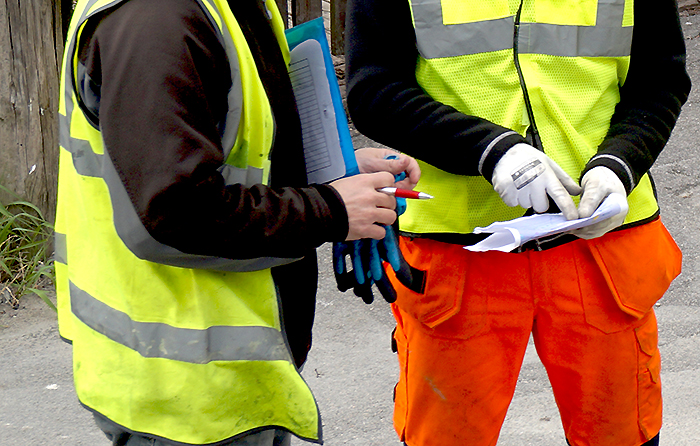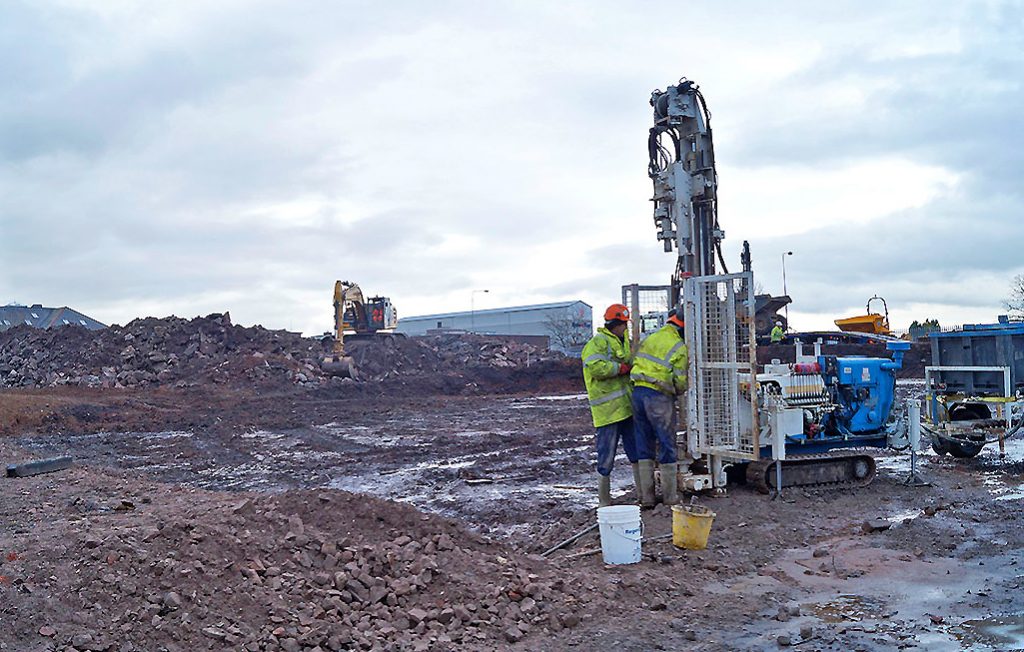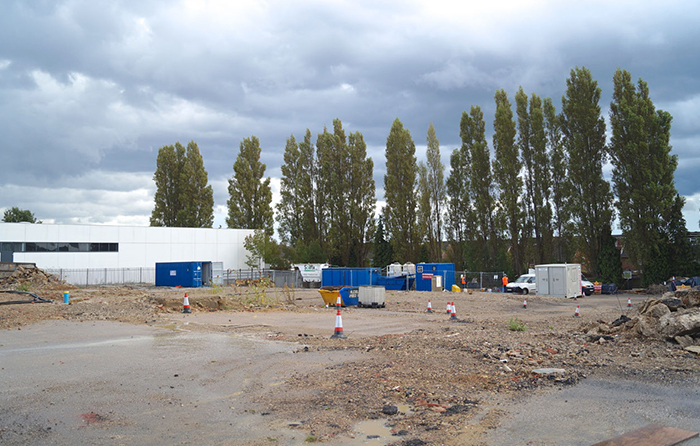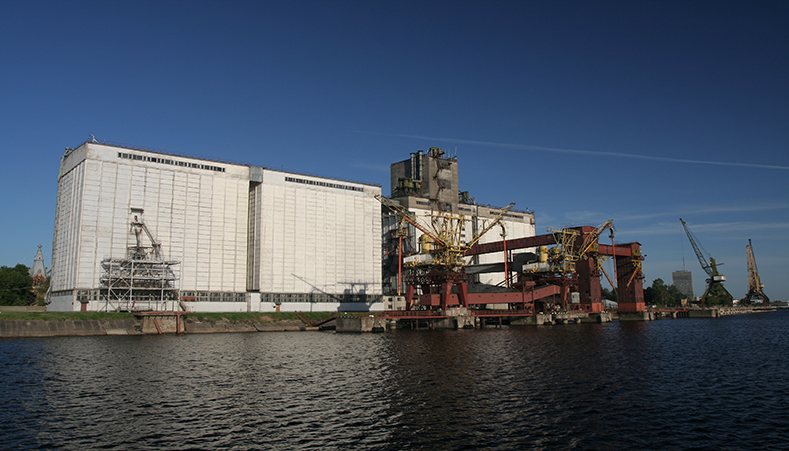In Situ Remediation of Petroleum Hydrocarbons in Deep Chalk
From LNAPL to less than 1,000 μg/L in seven months using an integrated treatment approach Read More
Petroleum Contaminated Groundwater Treatment, West London, UK
Installation of ORC-Advanced barrier successfully reduced the contaminant influx onto the site, allowing for site redevelopment without any disruption Read More
Hotspot Treatment of Petroleum Hydrocarbons – North West, UK
Phased, in situ treatment with PetroCleanze and ORC-A Socks allows main contractor to keep programme on trackRead More
PetroCleanze Increases Efficacy of Pump and Treat System – Reading, UK
Treatment example of LNAPL and smear zone in bedrock. PetroCleanze enhanced the efficacy of the existing P&T system, reducing P&T costs onsite.Read More
Enhanced Recovery & Biodegradation of Petroleum Hydrocarbons – Sweden
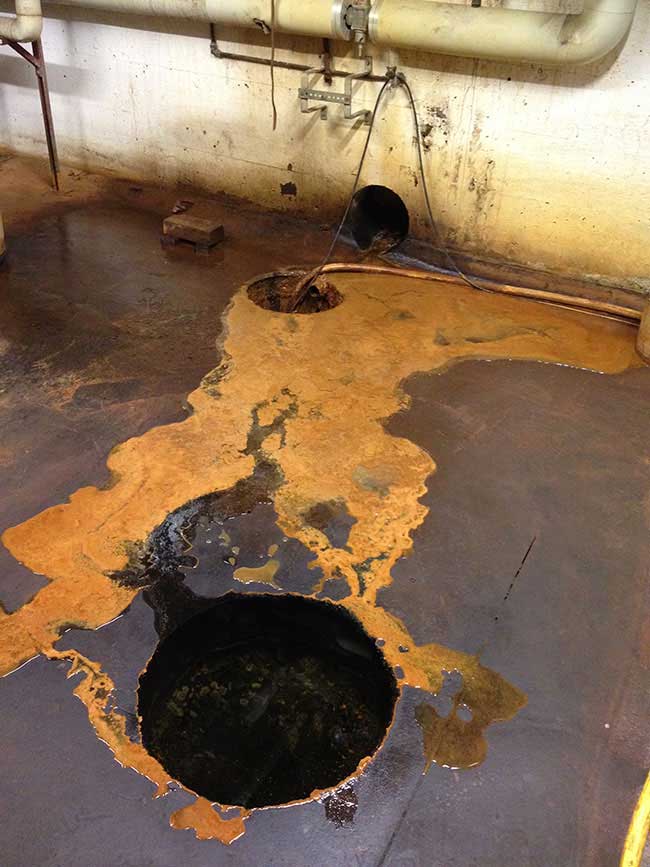
Summary
A site investigation undertaken by a remediation contractor in Växjö, Sweden, identified up to 1.4 m of LNAPL on top of the groundwater beneath an industrial unit. The source of the contamination was a boiler in the basement of the facility. It was determined that the contamination posed a vapour risk to the site users. The proposed strategy was therefore to remove the LNAPL, reduce the adsorbed mass and treat the dissolved phase contamination to low levels. This was to be completed within the building, it’s basement and the car park downgradient.

Treatment
In order to efficiently address both the free and dissolved phase petroleum hydrocarbon contamination an integrated in-situ remediation strategy was adopted. A Multi-Phase Extraction (MPE) system was installed across the target area. This was used firstly to extract the easily removable LNAPL observed at the site. Following this, several round of PetroCleanze® were applied into the subsurface to cause the temporary desorption of the soil contamination within the smear zone. The MPE system was then used to remove this ‘rebound’ each time.
Once no further LNAPL was observed after the PetroCleanze application, ORC Advanced® was applied to enhance the biological degradation of the residual dissolved phase contamination to reach the target values.
What’s Special
- An integrated in situ remediation method allowed for treatment of LNAPL down to low dissolved phase contamination under an industrial unit, avoiding any demolition or excavation.
- PetroCleanze enhanced the performance of the MPE in order to reduce the asymptote achieved and avoid rebound from residual sorbed contamination.
- Augmentation of the MPE reduced time onsite and the cost of the remediation programme.
- ORC Advanced was used once only dissolved phase contamination was observed, maintaining the efficiency of the remedial programme and successfully achieving stringent target values.
Fuel spill treated using RegenOx at a Swedish military base in Afghanistan
RegenOx® has been successfully used as an emergency response cleanup reagent by the Swedish Army to remediate a minor fuel spill in Afghanistan.Read More
PlumeStop® and ORC Advanced® Treat BTEX to Non-Detect in 1 Month
Project Highlights
- Benzene (BTEX) and TPH-d (diesel) were reduced to non-detect within one month with no rebound
- Pre-project verification testing provided hydrogeological data to optimize the successful application of PlumeStop and ORC Advanced
- Active site did not impede remediation efforts
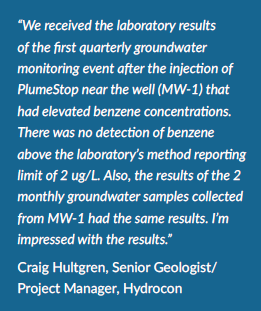
Project Summary
An active gas station in the Pacific Northwest was impacted with BTEX concentrations from a petroleum release. Following remediation of the source, residual BTEX concentrations persisted in a down gradient well. A new combined remedies in situ program using PlumeStop and ORC Advanced was designed. Following the verification testing, REGENESIS co-applied PlumeStop and ORC Advanced into the residual BTEX plume. After one month, sampling was conducted showing contaminants had been dramatically reduced to non-detect levels.
Remediation Approach
REGENESIS worked closely with the project consultant to complete a multi-step verification process prior to remediation. This procedure included a clear water injection to test aquifer properties and soil borings for detailed characterization of the proposed treatment area. This was followed by a pilot injection of PlumeStop to test distribution. The verification testing found that despite soils at the site being classified as clays and silts, there was a sufficient amount of sand present to allow for good distribution. Injection pressures remained below 5 psi for PlumeStop and below 10 psi for ORC Advanced. Distribution of greater than 12 feet was also observed. The verification process was an integral part of the project, helping to more accurately characterize true hydrogeologic conditions. Technical Engineers were able to take the information obtained from the verification process and optimize the PlumeStop and ORC Advanced design. The co-application of the two technologies quickly sorbed dissolved-phase contaminants and promoted aerobic biodegradation.
REGENESIS Solution Applied
PlumeStop Liquid Activated Carbon™ is composed of very fine particles of activated carbon (1-2μm) suspended in water through the use of unique organic polymer dispersion chemistry. Once in the subsurface, the material behaves as a colloidal biomatrix binding to the aquifer matrix, rapidly removing contaminants from groundwater, and enhancing permanent contaminant biodegradation. ORC Advanced is a proprietary formulation of food-grade, calcium oxy-hydroxide that produces a controlled release of molecular oxygen for periods of up to 12 months upon hydration.
Results
Residual BTEX and TPH-d concentrations lingering for years are common for gas station sites and often are the only obstacle to closure. The combined remedies application of PlumeStop and ORC Advanced demonstrates a unique ability to attain non-detect levels in a short time frame with substantial cost savings over other approaches, including natural attenuation.
PlumeStop and ORC Advanced Treat BTEX to Non-Detect in 1 Month
Project Highlights
- Benzene (BTEX) and TPH-d (diesel) were reduced to non-detect within one month with no rebound
- Pre-project verification testing provided hydrogeological data to optimize the successful application of PlumeStop and ORC Advanced
- Active site did not impede remediation efforts
1m 53s reading time
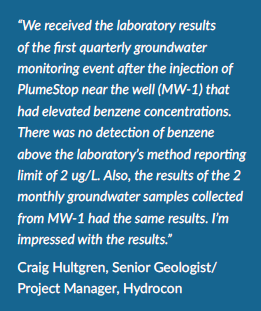
Project Summary
An active gas station in the Pacific Northwest was impacted with BTEX concentrations from a petroleum release. Following remediation of the source, residual BTEX concentrations persisted in a down gradient well. A new combined remedies in situ program using PlumeStop and ORC Advanced was designed. Following the verification testing, REGENESIS co-applied PlumeStop and ORC Advanced into the residual BTEX plume. After one month, sampling was conducted showing contaminants had been dramatically reduced to non-detect levels.
Remediation Approach
REGENESIS worked closely with the project consultant to complete a multi-step verification process prior to remediation. This procedure included a clear water injection to test aquifer properties and soil borings for detailed characterization of the proposed treatment area. This was followed by a pilot injection of PlumeStop to test distribution. The verification testing found that despite soils at the site being classified as clays and silts, there was a sufficient amount of sand present to allow for good distribution. Injection pressures remained below 5 psi for PlumeStop and below 10 psi for ORC Advanced. Distribution of greater than 12 feet was also observed. The verification process was an integral part of the project, helping to more accurately characterize true hydrogeologic conditions. Technical Engineers were able to take the information obtained from the verification process and optimize the PlumeStop and ORC Advanced design. The co-application of the two technologies quickly sorbed dissolved-phase contaminants and promoted aerobic biodegradation.
REGENESIS Solution Applied
PlumeStop Liquid Activated Carbon™ is composed of very fine particles of activated carbon (1-2μm) suspended in water through the use of unique organic polymer dispersion chemistry. Once in the subsurface, the material behaves as a colloidal biomatrix binding to the aquifer matrix, rapidly removing contaminants from groundwater, and expediting permanent contaminant biodegradation. ORC Advanced is a proprietary formulation of food-grade, calcium oxy-hydroxide that produces a controlled release of molecular oxygen for periods of up to 12 months upon hydration.
Results
Residual BTEX and TPH-d concentrations lingering for years are common for gas station sites and often are the only obstacle to closure. The combined remedies application of PlumeStop and ORC Advanced demonstrates a unique ability to attain non-detect levels in a short time frame with substantial cost savings over other approaches, including natural attenuation.
Manufacturing Site Gets Closure using In Situ Desorption with Vacuum Enhanced Recovery for Petroleum Hydrocarbons
Project Highlights
- VOC levels show a 99% decrease in soil and 66% decrease in groundwater contamination
- Unique desorption reagent and enhanced recovery process approved for use by Michigan DEQ
- Site closure granted for two petroleum releases within same general area
Project Summary
Two separate UST petroleum releases were identified within the same general area of the manufacturing site with one being more recent and the other an older historic release. Following soil hydro-excavation activities which were limited by a building footprint, residual VOC contamination was identified at concentrations of 770,820 μg/kg in soil and 12,387 μg/L in groundwater. In Situ remediation using PetroCleanze® , an enhanced desorption/ extraction technology was planned for use to treat the remaining high levels of VOCs. Petro- Cleanze is optimized to desorb bound hydrocarbon mass and drive it from the soil matrix into the aqueous phase. Once pollutants are moved into the dissolved phase, its ability to chemically oxidize portions of the contamination coupled with enhanced recovery (physical extraction) effectively reduces contaminant concentrations.
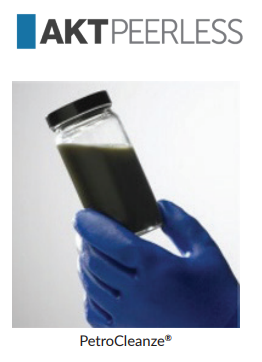
Remediation Approach
A total of four initial PetroCleanze injection/extraction events took place in two treatment areas close to where the UST was once located. Each injection used a total of 1,320 lbs. of PetroCleanze and 925 lbs. of RegenOx Part A; the material was applied as a 5% solution (2000 gallons) through eight direct-push injection points. The vertical treatment interval ranged between 5 feet to 15 feet below ground surface. Following each injection, a vacuum enhanced recovery event was performed approximately two weeks later. The two week period was critical as it allowed PetroCleanze time to react and free up the bound hydrocarbon mass. Approximately 2,000 gallons of petroleum impacted water was removed during each extraction event and disposed of at a licensed disposal facility. Correlating soil samples in key treatment areas indicated that concentrations were reduced up to 99% with the exception of one area which required an additional injection event. Based on the site conditions, subsurface obstructions limited the influence of the PetroCleanze to this area. Therefore, a fifth injection event was conducted immediately surrounding the residual area in which the soil contamination remained to directly address the soil contamination. Correlating soil samples following the additional injection event indicated the concentrations were reduced up to 90%. Six months after treatment, groundwater VOC levels in EW-2 were reduced from 12,000 μg/L to 4000 μg/L marking a 66% reduction in the treatment zone. Within the same well, following each injection/extraction event, TPH data reported concentrations consistently decreasing from 20,000 μg/L to 10,000 μg/L to 5,900 μg/L. In 2014, as a result of the significant reductions in both soil and groundwater contamination, Michigan DEQ approved restricted UST closure for the two petroleum releases with no further action required.
Technology Description
PetroCleanze is a customized formulation of the widely used RegenOx in situ chemical oxidation technology. The primary function of PetroCleanze is to increase the desorption rates of hydrocarbons bound in saturated soil and make them available for more efficient and rapid treatment using a range of enhanced recovery technologies.
ISCO Treats High Levels of TCE with Planned Enhanced Bio for TPH Treatment
157,000 lbs. of PersulfOx® Applied to Treat Illinois Manufacturing Facility
Project Highlights
- Remediation mandated after oil sheen observed in river adjacent to manufacturing facility
- In Situ chemical oxidation (ISCO) paired with excavation to remediate site
- Tight treatment deadline met through supply of 51 PersulfOx SuperSacks, containing 2,204 lbs. each, which were delivered within a few days’ notice
- TPH soil plume has been reduced by >90% (from 6,111 cubic yards to 555 cubic yards)
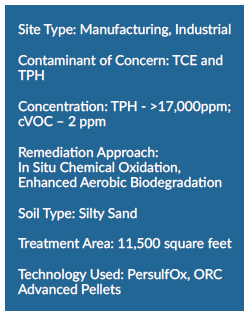
Project Summary
An operating metal fabrication facility, located in Illinois, caused subsurface impacts from the use of cutting oils and degreasing solvents. This resulted in high levels of TPH and TCE in soil and groundwater. The state of Illinois cited the facility for a violation when an oil sheen was observed seeping from the property into an adjacent river. A mechanical oil recovery system was installed and absorbent booms were used to stop oil from reaching the river. ISCO was selected as the remediation approach to treat the contamination below the active facility. The TCE area was treated with PersulfOx via injection wells and a soil mixing application with an excavator.
Remediation Approach
Prior to the start of remediation activities, a change in the primary consultant was made and a new consultant was brought in. The new consultant imposed a tight deadline of several months to complete the full scope of remediation activities. REGENESIS was able to assist with keeping the project on-deadline through the timely delivery of 51 PersulfOx SuperSacks, containing 2,204 lbs. each. The PersulfOx SuperSacks were delivered within a few days’ notice. The consultant installed a series of injection wells within and outside of the building. PersulfOx was injected into these wells during three applications over a three-month period. Additionally, the TCE area was treated with PersulfOx® through a soil mixing application using an excavator. The final step of the remediation plan is to treat the TPH-impacted soils outside the building through excavation and the application of Oxygen Release Compound (ORC®) Advanced Pellets which will supply a long-term oxygen source of oxygen for enhanced bioremediation of the residual TPH. The client is also evaluating the use of PlumeStop to change the FOC value of the soil for a site specific Tier 3 closure level via MNA for an area that had extremely high TPH values >40,000ppm.
Technology Description
PersulfOx is a sodium persulfate-based chemical oxidation technology which destroys both hydrocarbon and chlorinated solvent type contaminants in the subsurface. PersulfOx contains a built-in catalyst which activates the persulfate component and generates contaminant-destroying free radicals without the need for the addition of a separate activator.
ORC Advanced Pellets are a pelletized version of REGENESIS’ widely used ORC Advanced and are designed specifically for direct application into excavations, tank pits and trenches. This pelletized, dry application material minimizes airborne dust while eliminating the need for specialized equipment and spray water required for powder-slurry applications.

 Americas
Americas Europe
Europe Français
Français Deutsch
Deutsch Italiano
Italiano Español
Español